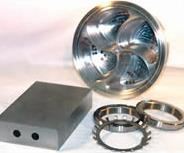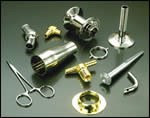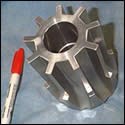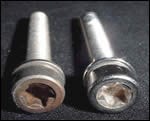Electropolishing Returns To The Surface
Manufacturing engineers are taking a closer look at some old-line processes to help solve some critical metal surface problems. Electropolishing is one such process worthy of closer inspection.
Metal finishing has long been regarded as a last-step process with the main purpose of making a metal part look attractive. Vendors of various metal finishing processes certainly emphasize looks over function in their Web sites and literature. However, manufacturing engineers are taking a closer look at some old-line processes to help solve some critical metal surface problems. Electropolishing is one such process worthy of closer inspection.
Electropolishing applications have been in place since the early 1950s. Advancements in the plating industry during World War II led to new technologies, and electropolishing grew from those developments. Through the decades, electropolishing has been confused with electroplating, thanks to the shared technology. While some of the physics in the two are similar, the processes themselves could not be more different.
In the simplest definition, electropolishing is the controlled removal of surface metal using a combination of chemicals and electrical current. While plating deposits metal on a surface, electropolishing is a reverse plating process, leaving no coating to chip, peel or flake off. The operating words are "controlled removal." Electropolishing, unlike other metal stripping processes, can be tightly controlled to remove metal ± 0.0001 inch, allowing the process to be used on a range of high-tolerance metal parts.
When a metal is electropolished, surface metal is dissolved along with grinding compounds, heat treat discoloration, weld scale and other imperfections. An electropolished metal part is stripped of imbedded impurities, leaving the base metal surface clean and bright. While electropolishing got its start in the brightening of metal parts, automated process controls led to a host of metal improvement benefits that are used by manufacturers worldwide. A significant volume of shiny electropolished parts can be found buried in transmissions, as medical implants or as parts of complex assemblies performing a host of important functions.
Over the decades, the controlled metal removal benefits of the process have led to literally tens of thousands of applications. Though the application areas span many dozens of alloys and industries, they fall into four general categories of greatest interest to those involved with precision machining: deburring, microfinishing, corrosion resistance and size control.
Deburring
When properly applied, electropolishing dissolves metal from edges more rapidly than flat surfaces. This "current density" aspect of the process is similar to plating. Electroplating tends to build metal more rapidly on part edges. Since electropolishing removes surface metal, the physics of current density are put to a great advantage. Burrs are often reduced or completely eliminated. From a practical matter, fine burrs left from grinding, lapping, honing, milling, blanking or other similar processes are good candidates.
As electropolishing removes metal from the entire part, consideration should be made for tolerances on critical surfaces. Those parts with critical final dimensions needing deburring must accommodate the metal removal. An experienced electropolisher can provide appropriate AQL data that will show dimensions are within tolerance and that they have a good handle on process parameters.
Electropolishing is a non-mechanical process. Since the parts are not tumbled or impinged, highly complex or fragile parts are excellent candidates for the process. A part that has burrs over several surfaces can often be electropolished at a fraction of the cost of other more traditional methods.
Microfinishing
While current density is an advantage on edges and burrs, those same physics work on flat surfaces as well. When metal is removed from the surface of a part, metal removal is more rapid on high points of the surface and less so on low points. Electropolishing has been used in low Ra applications where frictional resistance is critical. Hydraulic, medical, automotive and many other components needing smooth surfaces benefit from the smoothing aspects of electropolishing. Again, being an electrochemical process, all surfaces are processed simultaneously.
An important consideration here is that the process works equally well on dead soft to fully hardened components. Unlike any other metal removal process that depends on mechanical work (grinding, cutting, and so on), electropolishing can be performed after heat treat or induction hardening processes. Highly complex, fragile or multi-alloy assemblies are all possible candidates, as fixturing with other processes becomes problematic on these types of parts.
In general, Ra values are cut by 50 percent in the range of 4 to 32 Ra. Considering this range is where most low-friction applications lie, electropolishing may be a candidate on fragile or complex parts and assemblies. It is important to note that almost any conductive metal can be electropolished for a Ra application, including stainless, carbon steel, brass, aluminum, copper, Monel, Inconel and more. Since the surface is free of any other coating, the low-friction surface is more or less permanent, without the peeling or delamination problems common with low-friction coatings.
Corrosion Resistance
Many industries have moved to harsh chemical environments for their stainless components. While some stainless alloys are tuned for corrosive environments, the metals often need help to meet or exceed corrosion standards for field use.
While passivation is often specified to improve corrosion resistance, electropolishing users have decades of data that show actual corrosion resistance 30 times higher than passivation. Two reasons make electropolishing the gold standard in improving corrosion resistance: imbedded impurities and surface irregularities.
Most metalworking operations imbed contamination into a metal part. Metal fragments, sulfur from lubricants, polishing and grinding compounds, and other contamination are normal and unavoidable parts of metalworking. That contamination, when closely mated with the metal alloy, creates the opportunity for galvanic corrosion to occur and spread through the base metal. The mating of contamination and base metal occurs on surfaces that trap moisture or chemicals, further accelerating the corrosion.
By removing surface metal, electropolishing removes the introduced contamination and reduces surface checks that retain moisture and chemicals. By reducing the opportunity for corrosion to begin and the hiding places for corrosion to take place, the electropolished metal is left more corrosion-resistant.
While most corrosion applications are on stainless steel and related alloys, other metals benefit to a lesser extent. Carbon steel will not rust as readily, brass will not tarnish as rapidly, and aluminum will not pit as easily after electropolishing. However, these other alloys will eventually rust or corrode since electropolishing is not a coating process.
For those engineers looking to improve corrosion resistance, it is best to establish field test standards or salt spray/fog tests per ASTM B-117. Actual corrosion tests are far more predictive than theories of "high chromium layers" that try to predict laboratory standards for corrosion. Electropolishing vendors should be able to provide assistance in finding corrosion test parameters for specific industries.
Size Control
If electropolishing can remove a controlled amount of surface metal, what about salvaging oversized parts? Gear makers have been users of electropolishing to save expensive parts. An experienced practitioner of electropolishing can save plenty of parts from the scrap bin. If a part is machined oversized, is fabricated from material thicker than specification or grows in dimension from heat treat, it may be a good candidate for electropolishing. With the aid of modern masking materials and advanced tooling, electropolishing can focus on specific journals, external surfaces and inside bores.
In a few cases, electropolishing has been used to dimension parts that otherwise would require expensive and custom material orders. The part can be fabricated from standard material and its thickness reduced to final specification by dissolving the surface metal. As long as metal removal is less than 0.002 inch, electropolishing may provide a finished dimension at a fraction of the cost and leadtime of special materials.
The Next Step
As electropolishing has moved from art to science in the last 50 years, applications for the metal removal process have expanded rapidly. Thanks to advancement in controlling metal removal, almost every industry and metal is a candidate for experimentation. Significant improvements in cost reduction and quality can result from such exploration.
Read Next
Getting More Bang For Your Deburring Buck
Today, customers demand parts that are burr-free, which would suggest aggressive deburring. At the same time, they want parts that are free of scratches and dings, which calls for gentle processing. There is a non-conventional deburring process that not only completely removes burrs from even difficult-to-reach part areas, but also leaves machined features and surface finishes intact and parts free of nicks and scratches. The process is called thermal deburring.
Read MoreBurnishing For Improved Part Quality And Lower Costs
In today’s cost-conscious manufacturing environment, what shop owner or production manager would not be excited about achieving accurate size and fine finish on the original machine on which parts are produced? Roller burnishing can help users eliminate secondary operations for substantial time and cost savings, while at the same time improving the quality of their product.
Read MoreMicrofinishing Helps Shop Meet Demanding Specs
A high-volume auto part included specifications for something Grand Haven Steel Products (Grand Haven, Michigan) had not encountered before in its bids.
Read More





















